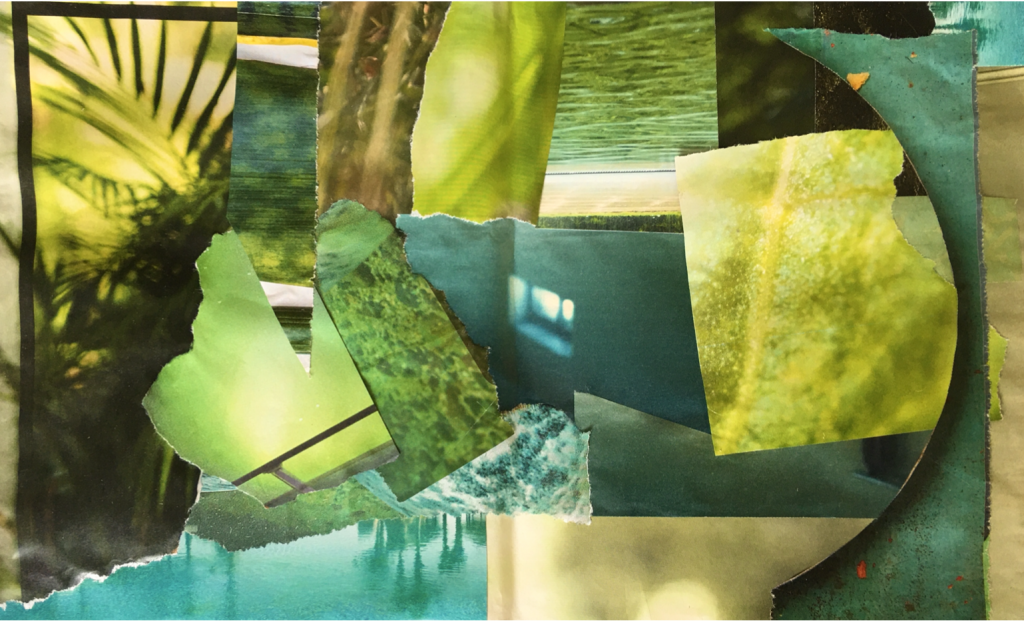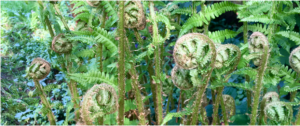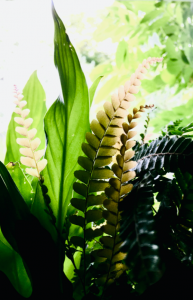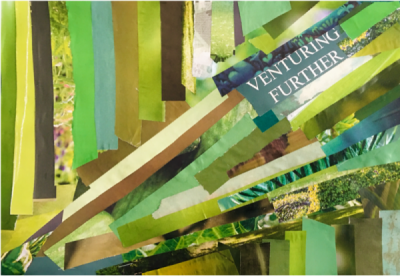by Kate Kennington Steer, all images by Kate Kennington Steer
As I mentioned in a previous post for Godspace written in 2016, I have long been fascinated by and inspired by Hildegard of Bingen (1098-1179), not least because despite her struggles with persistent ill health, she was a writer, a composer, a scientist, a preacher, a prophetic visionary, and an Abbess of two Benedictine convents; and because, for me, she personifies what I called back in 2016 ‘expressive strength in creative weakness’. Here’s my concluding passage from that post:
It seems to me that it takes a very particular type of strong personality to be able to continue to live a
creative, fruitful, flourishing life in the service of God and others; and that such a life-force is only found in those whose strength is based on a recognition of their absolute vulnerability and powerlessness. For Hildegard this life-force came from what she idiosyncratically identified as ‘viriditas’, a ‘greening’ of the spirit that forms the innate connection between God’s goodness in the heart and God’s goodness in the earth; a connection Hildegard personifies as Grace. ‘Greening’ is the epitome of God’s blessing to those God loves… As I struggle to find ways in which I might join every day with the Creator in creating and healing, Hildegard’s expressive, exuberant celebration of the ways in which we may all still be greened continues to echo down the centuries to encourage me this day.
During the COVID-19 Lockdown, I have returned to actively thinking about viriditas as part of my ongoing #projectgreen: an intentional, slow, gradual, mindful multimedia exploration of the colour green, asking what might I learn from its associations and usages (both traditional and modern), and what do I need to notice about the presence and absence of this colour in my life at this time?
 Philip Larkin, in a line from his poem ‘The Trees’, wrote, ‘their greenness is a kind of grief’. This pinpoints an association that has been humming through my writings this summer, as I have charted the Sun’s arc, and marked moments of particular turning and potential thresholds of revelation. I realise that, as my attention has shifted through the building of light and its affect on the intensity of greens surrounding and greeting me in my Mum’s garden, that once I was past the zenith of the Summer Solstice, I have been looking at green in a (literally) different light, as darkness begins to make its presence felt round the edges of each day as the peak of the season passes. It sounds so obvious to say green is not a homogeneous entity, a single universally understood colour. Nor, of course, is light. My late Summer light is not the same even across the northern hemisphere, let alone the light experienced on other continents enjoying different seasons. Something of this found its way into ‘blank green’, a poem found from the words of my journaled reflections on this collage I made:
Philip Larkin, in a line from his poem ‘The Trees’, wrote, ‘their greenness is a kind of grief’. This pinpoints an association that has been humming through my writings this summer, as I have charted the Sun’s arc, and marked moments of particular turning and potential thresholds of revelation. I realise that, as my attention has shifted through the building of light and its affect on the intensity of greens surrounding and greeting me in my Mum’s garden, that once I was past the zenith of the Summer Solstice, I have been looking at green in a (literally) different light, as darkness begins to make its presence felt round the edges of each day as the peak of the season passes. It sounds so obvious to say green is not a homogeneous entity, a single universally understood colour. Nor, of course, is light. My late Summer light is not the same even across the northern hemisphere, let alone the light experienced on other continents enjoying different seasons. Something of this found its way into ‘blank green’, a poem found from the words of my journaled reflections on this collage I made:
 and suddenly there is no such thing as a blank green
and suddenly there is no such thing as a blank green
see the paper crinkled by blued glue into
precipitous mountain top passes
and plunging crevasses the shape of a missing
plate framing bokehed sun shapes
masking whatever is currently unseen
glimpse rust flakes becoming moss trails over flocked rocks inviting me to clamber into depths of evergreen
rich darkness enfolding me in forest
hear its promise to hold me in pined perfume
setting me down on the winding track into untold lostness
or perhaps only as far as the blue pool
where my yesness continues to echo off sunbaked
clay banks and the Spirit’s hovering ripples water
in a constant play of eddy and still in delight unhesitating I plunge along the ridge of upturned leaf stirring minute hairs freed from dew
parting to reveal a stippled pathway of midgreens leading me on past the comfort of High Windows and Larkin’s words of baptism in light
over the whale’s crustacean enhanced hide
onto the uneven terrain of the seabed itself where murk and shadow disrobe what light may veil
until I am spouted upward propelled into sky
until a rail steadies me
onto a look out over the aura borealis
a swirl of pea green against unimaginable layers of receding blueback purpled at the edges
until returning to present I am pierced again
by the stripes of the tongued plant
(though lacking a mother-in-law how can I know
its’ true speech?) I traverse the hinterland of understanding as it dips into hollows of familiar yellow and dances along blazing minty ice cream heat heights
reaching past the softmeadow grass and the friable hayfield into unexplored tropics extended fans and
upside down paintbrush trees mirrored
in jewelled swimming pools transfigured emerald
against a jungled sky
until here in this coolness
here where I am overshadowed by such unfamiliar shapes here may I rest
This kind of welding of written and visual expression is something that speaks intently to me (as the name for my blog imageintoikon suggests). It is the path I wish to explore in future works, even if for the moment I needs must be content with an A4 collage made in bed, doodles made beside scribbles in a journal that is almost never beyond arm’s reach. Again, this brings me back to the tensions that Hildegard lived with: the reach of her earthly ambitions were tempered by persistent ill health, and yet, her trusting perception of viriditas beyond the surface of all things, is what helps me, hundreds of years later, see the ‘greening power of God suffusing all life and creation’:
Viriditas is the force sustaining life each moment, bringing newness to birth. It is a marvellous image of the divine power continuously at work in the world, juicy and fecund … The prophet Isaiah writes that “the wilderness and the dry land shall be glad, the desert shall rejoice and blossom; like the crocus it shall blossom abundantly, and rejoice with joy and
singing” (Is 35.1-2) This abundant blossoming is the provenance of viriditas. We are called to wander through the desert tending to the abundant gifts of viriditas, the creative life-force of everything alive. Hildegard’s wisdom is for living a life that is fruitful and green and overflowing with verdancy. She calls us to look for fecundity in barren places …
(original emphases)(Christine Valters Paintner, Illuminating the Way, 161-2, 164, 170)
In one of her books of visions, the Liber Vitae Meritorum, Hildegard receives a dialogue between two characters: Heavenly Joy and Worldly Sadness. In the opinion of Heavenly Joy, Worldly Sadness is sad because she does not ‘observe the sun and moon and stars and all the decoration of the greenness [viriditas] of the earth and consider how much prosperity God gives man with these things’. By contrast, of herself Heavenly Joy says:
 “I possess heaven, since all that God created, and which you call noxious, I observe in its true light. I gently collect the blossoms of roses and lilies and all greenness [viriditas] in my lap since I praise all the works of God, while you attract sorrows to you because you are dolorous in all your works.”
“I possess heaven, since all that God created, and which you call noxious, I observe in its true light. I gently collect the blossoms of roses and lilies and all greenness [viriditas] in my lap since I praise all the works of God, while you attract sorrows to you because you are dolorous in all your works.”
Hildegard’s viriditas reminds me to notice the gifts I am given in the ordinary details of my life around
me. Viriditas reminds me that the Spirit always waits in readiness to ‘green’ my soul’s barren places and our planet’s damaged earth. There is always hope within viriditas. In the action of the Spirit’s ‘greening’ I am becoming who God longs for me to be. In the light that is itself a gift, I am called to notice and collect together the incidents of greening around about me, like where ‘moss trails over flocked rocks/ inviting me to clamber into depths of evergreen’. The Spirit’s ‘greening’ invites me to open my eyes, to see where the Spirit ‘sets me down’ to find even more green, and though at first I may appear surrounded by ‘lostness’, the ongoing ‘greening’ of my soul promises always to lead me into the heart of God’s calling for me.
So perhaps this is the key to both viriditas and #projectgreen: they symbolise the continual flow of emergence and re-emergence of gratefulness in me, which inexorably leads me to pause to praise my Maker the Great Artist, with thanksgiving in my heart, before I move on, powered by viriditas, into the day God lays before me, welcoming whatever it may bring. Today, using Hildegard’s words of praise of the Holy Spirit, I ask that viriditas will bless us this day, and all the days to come:
Out of you clouds
come streaming, winds
take wing from you, dashing
rain against stone;
and ever-fresh springs
well from you, washing
the evergreen globe [terra viriditatem].
(From ‘O ignis Spiritus Paracliti’ (trans Barbara Newman Symphony of the Harmony of Celestial Revelations, 148-151))
[an extended version of this post (with more examples of #projectgreen) can be found at imageintoikon.com)

